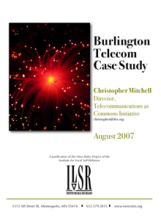
Fast, affordable Internet access for all.

Though Danville, Virginia, was hit hard by the simultaneously decline of tobacco and textile industries, the community has responded: Danville Utilities has been building a state of the art all fiber network. Like many communities, they built a backbone and connected the schools and government buildings first. They then started to connect businesses. This summer they will be rolling out a pilot project to connect a few thousand homes to their open services network. As they add more potential subscribers to the network, they will be more attractive to service providers. This should spur competition, increase innovation, reduce prices, and otherwise make the network more desirable to subscribers. Though the open access idea has been somewhat maligned following the troubles of UTOPIA (many of which had nothing to do with the wholesale model), the consulting firm Design Nine has helped both nDanville and The Wired Road move forward with a revised wholesale-only model. This approach may be gaining traction nationally depending on how the rules for the stimulus grants are written: Stimulating Broadband suggests broadband stimulus funding from USDA will favor "projects that will deliver end users a choice of more than one service provider." Back in Danville, the schools have much faster Internet access while shaving their telecom budgets. Other key features are listed on the network's site, including:
The nDanville Medical Network project has begun to connect a majority of doctor’s offices and medical clinics around the city. The network is already being used by the Danville Regional Medical Center to provide super high speed connectivity to satellite clinics and offices in Danville.
Last year, Last Mile featured an article on the network that includes some numbers, goals, and history of the project. Below is a video that discusses some of the benefits of the network.
During the last 25 years, telecommunication has moved away from government–owned or regulated monopolies toward privatization with competition and oversight by independent regulatory agencies — PCR policies. We present data indicating that PCR has had little impact on the Internet during the last ten years in developed or developing nations, and discuss the reasons for this. We then describe several ways government can go beyond PCR, while balancing needs for next generation technology, decentralized infrastructure ownership, and immediate economic stimulus. We conclude that there is a need for alternatives to the expedient action of subsidizing the current Internet service providers with their demonstrated anti–competitive bent. The decisions we make today will shape telecommunication infrastructure and the industry for decades.

This is the report developed by a Broadband Advisory Committee established in 2006 in Saint Paul, Minnesota. It recommended a phased approach to building a network that could ultimately offer a full FTTH open-access network to everyone in Saint Paul.
The BAC recommends an incremental, phased-approach to creating a publicly controlled network that uses both short- and long-term solutions. This approach would allow City and community leaders to evaluate and make decisions at key points throughout the process. The network would begin by creating a partnership with key Saint Paul public institutions to address their own broadband infrastructure needs. This partnership would participate in the development of a collaborative and cooperatively managed fiber network that would serve the immediate- and the long-term telecommunications needs of the partners. The cooperative venture would be leaveraged through the efficient maximization of the partners' pooled resources. The network has been coined the Community Fiber Network (CFN). Possible initial partners include: City of Saint Paul, Ramsey County, Saint Paul Public Schools, and State of Minnesota. The BAC envisions that the CFN would have the ability to grow organically, developing in stages as new partners are added, with the possible long term goal of the CFN providing the momentum to build a city-wide fiber system to serve the entire Saint Paul community.


Burlington Telecom, a city department in the largest city of Vermont, offers a world class fiber-to-the-home network offering cable television, fast broadband, and telephone services. This case study explains how they did it.
ILSR issued a report in 2011 that updates this case study: Learning from Burlington Telecom: Some Lessons for Community Networks
Geoff Daily and Christopher Mitchell discuss open networks and competition in the television and broadband network sector.
This video is no longer available.